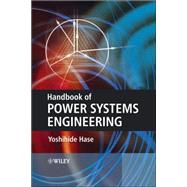
| Preface | |
| Acknowledgements | |
| About the Author | |
| Introduction | |
| Overhead Transmission Lines and their Circuit Constants | |
| Overhead Transmission Lines with LR Constants | |
| Stray Capacitance of Overhead Transmission Lines | |
| Supplement: Additional Explanation for Equation 1.27 | |
| Symmetrical Coordinate Method (Symmetrical Components) | |
| Fundamental Concept of Symmetrical Components | |
| Definition of Symmetrical Components | |
| Conversion of Three-phase Circuit into Symmetrical Coordinated Circuit | |
| Transmission Lines by Symmetrical Components | |
| Typical Transmission Line Constants | |
| Generator by Symmetrical Components (Easy Description) | |
| Description of Three-phase Load Circuit by Symmetrical Components | |
| Fault Analysis by Symmetrical Components | |
| Fundamental Concept of Symmetrical Coordinate Method | |
| Line-to-ground Fault (Phase a to Ground Fault: 1øG) | |
| Fault Analysis at Various Fault Modes | |
| Conductor Opening | |
| Fault Analysis of Parallel Circuit Lines (Including Simultaneous Double Circuit Fault) | |
| Two-phase Circuit and its Symmetrical Coordinate Method | |
| Double Circuit Line by Two-phase Symmetrical Transformation | |
| Fault Analysis of Double Circuit Line (General Process) | |
| Single Circuit Fault on the Double Circuit Line | |
| Double Circuit Fault at Single Point f | |
| Simultaneous Double Circuit Faults at Different Points f, F on the Same Line | |
| Per Unit Method and Introduction of Transformer Circuit | |
| Fundamental Concept of the PU Method | |
| PU Method for Three-phase Circuits | |
| Three-phase Three-winding Transformer, its Symmetrical Components Equations and the Equivalent Circuit | |
| Base Quantity Modification of Unitized Impedance | |
| Autotransformer | |
| Numerical Example to Find the Unitized Symmetrical Equivalent Circuit | |
| Supplement: Transformation from Equation 5.18 to Equation 5.19 | |
| The ¿-ß-0 Coordinate Method (Clarke Components) and its Application | |
| Definition of ¿-ß-0 Coordinate Method (¿-ß-0 Components) | |
| Interrelation Between ¿-ß-0 Components and Symmetrical Components | |
| Circuit Equation and Impedance by the ¿-ß-0 Coordinate Method | |
| Three-phase Circuit in ¿-ß-0 Components | |
| Fault Analysis by ¿-ß-0 Components | |
| Symmetrical and ¿-ß-0 Components as Analytical Tools for Transient Phenomena | |
| The Symbolic Method and its Application to Transient Phenomena | |
| Transient Analysis by Symmetrical and ¿-ß-0 Components | |
| Comparison of Transient Analysis by Symmetrical and ¿-ß-0 Components | |
| Neutral Grounding Methods | |
| Comparison of Neutral Grounding Methods | |
| Overvoltages on the Unfaulted Phases Caused by a Line-to-ground Fault | |
| Possibility of Voltage Resonance | |
| Supplement: Arc-suppression Coil (Petersen Coil) Neutral Grounded Method | |
| Visual Vector Diagrams of Voltages and Currents Under Fault Conditions | |
| Three-phase Fault: 3øS, 3øG (Solidly Neutral Grounding System, High-resistive Neutral Grounding System) | |
| Phase b-c Fault: 2øS (for Solidly Neutral Grounding System, High-resistive Neutral Grounding System) | |
| Phase a to Ground Fault: 1øG (Solidly Neutral Grounding System) | |
| Double Line-to-ground (Phases b and c) Fault: 2øG (Solidly Neutral Grounding System) | |
| Phase a Line-to-ground Fault: 1øG (High-resi | |
| Table of Contents provided by Publisher. All Rights Reserved. |
The New copy of this book will include any supplemental materials advertised. Please check the title of the book to determine if it should include any access cards, study guides, lab manuals, CDs, etc.
The Used, Rental and eBook copies of this book are not guaranteed to include any supplemental materials. Typically, only the book itself is included. This is true even if the title states it includes any access cards, study guides, lab manuals, CDs, etc.